This is an archived article that was published on sltrib.com in 2016, and information in the article may be outdated. It is provided only for personal research purposes and may not be reprinted.
Though Utah is expected to have an average to mild wildfire season this year, Sue Stewart is still a little fearful.
Words like "worry" and "concern" repeatedly creep into her speech as she talks about the seemingly optimistic 2016 forecast from the U.S. Forest Service's predictive services branch. And her fear, perhaps, isn't misplaced: Appearances statewide suggest a dark picture for fire potential.
After a wet spring, tall grasses are growing across Utah, and with the anticipated high temperatures for June and July, those plants will dry out quickly, creating large fields of fuel for a spreading fire.
Forest areas in northern Utah also face the consequences of shifting climate patterns, where bark beetles are no longer killed off by Utah's more recent mild winters. The overpopulating bugs infect trees, producing loads of dry timber in dense areas, particularly the Uinta Mountains.
Combine those conditions with urban expansion into natural landscapes, where houses sit next to what Stewart calls "fire-prone ecosystems," and it is easy to see how someone who has worked with the Forest Service for more than seven years might be afraid, even when the outlook is relatively good.
But Stewart, director of fire and aviation with the Forest Service, concedes that the predictions are usually "pretty accurate," so she will put her faith in that, fire prevention techniques and some luck.
"I've got my fingers crossed that at least here in Utah, we're going to have another lucky year," she said. "[But] on these landscapes, fire is inevitable."
In what specialists consider an average wildfire season, about 55,000 acres of burn are expected in the state, less than 1 percent of Utah's land. That would be an uptick from last year — one of the mildest in recent records — where about 10,200 acres burned, according to USFS data.
Jason Curry, spokesman with the Utah Division of Forestry, Fire and State Lands, said vegetation is drying "earlier and quicker than last year," which is part of why this year is forecast to be slightly worse for wildfires.
Already in 2016 there has been a wildfire reported in every county, Curry said, though most have been small and quickly contained.
On Wednesday, crews were battling a lightning-sparked 400-acre fire in Iron County that was threatening 20 structures, including homes and outbuildings.
Last week in Juab County, a fire started by lightning topped 1,400 acres before it was contained five days later. Another fire last week, near St. George, damaged three buildings before it was contained at 10 acres.
Central western and southwestern Utah can expect the worst, Curry said, as those areas tend to dry out first and have less rain.
Stewart has "serious concerns" about the areas surrounding Cedar City and Santaquin, noting that nearby homes are particularly susceptible if owners fail to remove excess and overgrown plants or clear woodpiles around their property.
"It really exacerbates the challenges we have," she said, noting that homes are more likely to be damaged if owners don't plan ahead and create a buffer zone around their land.
Stewart doesn't believe 2016 will come anywhere near the "big and terrible" damage done in 2012, when more than 415,300 acres burned in Utah — an area about half the size of Rhode Island.
To help prevent some uncontrolled burns, USFS leads prescribed burnings to clear potential danger zones and protect houses. Stewart calls it "using fire to stop fire" and anticipates 27,000 acres of prescribed burns in Utah this year, costing about $7 million.
"We are true believers in managed landscapes," she said.
Utah is also surrounded by a "big blob of extreme fire potential" as Nevada, California and Idaho are all preparing for busy seasons. In Utah, Stewart hopes, people will see more smoke from those fires than from any within state borders.
Curry warns, though, that about half the wildfires are started by humans, and Utah could easily become a part of the "big blob" if people aren't careful when putting out campfires, extinguishing cigarettes and driving their vehicles off roads.
Twitter: @CourtneyLTanner









